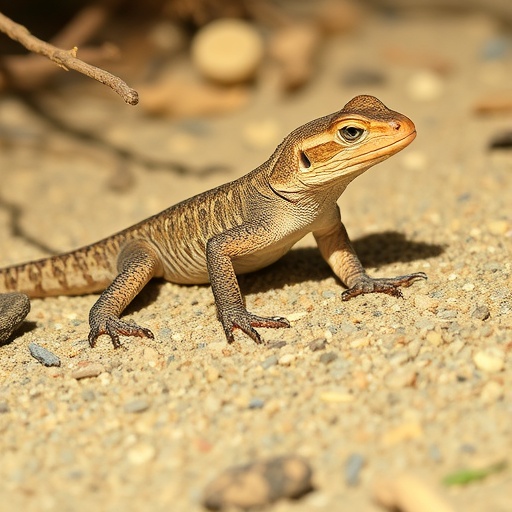In a fascinating exploration of lizard behavior, researchers Zheng, Liang, and Shi have delved deep into the intricate world of lizard burying dynamics in sandy environments. Their groundbreaking study, soon to be published in the esteemed journal Frontiers in Zoology, presents compelling evidence regarding the importance of toe fringes—small, often overlooked structures found on the feet of these reptiles. This investigation not only fills critical gaps in our understanding of lizard ecology but also raises significant questions about how these adaptations may have evolved in response to specific environmental challenges.
Lizards are remarkable creatures, exhibiting a wide array of adaptations that allow them to thrive in diverse habitats. Among their many survival strategies, the ability to bury themselves in loose substrates like sand is particularly noteworthy. By digging into the ground, lizards can evade predators, regulate body temperature, and maintain moisture in their bodies. However, the mechanics of how lizards achieve effective burial in highly mobile sand environments has remained poorly understood until now.
The study led by Zheng and colleagues zeroes in on toe fringes—fine, comb-like projections along the edges of lizard toes. While these structures have often been dismissed as minor anatomical features, the researchers posited that they could play a crucial role in enhancing a lizard’s ability to dig and navigate through shifting sand. Their hypothesis drew from observations of various lizard species, suggesting that variation in toe structure may correlate with the specific environmental challenges these creatures face.
To test their hypothesis, the researchers employed an innovative blend of field observations and laboratory experiments. Field studies were conducted in environments known for their dynamic sandy substrates, where the team meticulously recorded the digging behavior of multiple lizard species. They analyzed factors such as digging speed, depth of buriedness, and the overall efficiency of the burial process, seeking to link these parameters with the morphological characteristics of the lizards’ toes.
In the laboratory, they constructed controlled environments that simulated the conditions in which lizards typically dig. By manipulating the sand’s density and mobility, they observed how lizards with varying toe fringe morphology performed. This experimental approach allowed them to isolate the effects of toe fringes on digging efficacy, revealing correlations that bolstered their initial hypothesis.
Among the findings, it became evident that lizards with more pronounced toe fringes exhibited a marked improvement in digging efficiency. Not only did they burrow faster, but the structure of their toes appeared to provide greater traction, allowing them to push through loose sand more effectively. This was particularly interesting as it suggests that toe fringes are not merely incidental features; they may be a fundamental adaptation that enhances lizard survival in challenging environments.
The results of this study have profound implications for our understanding of evolution and adaptation. As lizards navigate the selective pressures of their environments, those that possess beneficial traits, such as enhanced toe fringes, are more likely to thrive and reproduce. This aligns with the principles of natural selection, underscoring the importance of studying small anatomical features that may influence an organism’s overall fitness.
Moreover, these findings highlight the intricacies of evolutionary biology, wherein even seemingly minor traits can have substantial impacts on an organism’s ability to adapt to and survive in its habitat. The study opens up new avenues for exploring how specific morphological traits evolve in response to environmental demands. It also prompts further inquiries into how other reptiles and creatures have developed unique adaptations tailored to their respective environments.
In addition to its ecological implications, this research contributes to the broader discourse surrounding the morphological diversity in reptiles. As scientists continue to unravel the complexities of evolutionary adaptations, understanding the role of toe fringes may offer similar insights into other species that share analogous traits. The study could lead to further investigations into whether similar adaptations exist in different lizard species globally, and how these features assist in their survival across varied terrains.
As the research community digests these findings, potential applications extend beyond zoology. Conservation efforts, for instance, could be informed by understanding which adaptations are crucial for specific environments, helping to shape strategies for protecting vulnerable lizard species. Furthermore, the principles derived from this study may inspire biomimetic approaches in robotics, where engineers can design machines that mimic the efficient digging capabilities observed in lizards.
In conclusion, Zheng, Liang, and Shi’s investigation into toe fringes and their role in lizard burying behaviors not only sheds light on a fascinating aspect of reptilian biology but also underscores the critical interplay between morphology and environmental adaptation. The implications of their findings resonate across multiple disciplines, prompting a reevaluation of how we understand evolutionary success in the animal kingdom. As we await the full publication of their study, one thing is clear: even the smallest features can pave the way for extraordinary survival strategies in nature.
The future of lizard research looks promising, with many questions remaining to be explored about the interactions between morphology, behavior, and ecology. As more studies like this emerge, we anticipate an enriched understanding of the complex adaptations that allow these remarkable reptiles to thrive in their ever-changing environments. This is just the beginning of an exciting journey into the evolution of life beneath the sands.
Subject of Research: Importance of toe fringes in lizard burying behavior in mobile sand.
Article Title: Are toe fringes important for lizard burying in highly mobile sand?
Article References:
Zheng, P., Liang, T. & Shi, L. Are toe fringes important for lizard burying in highly mobile sand?.
Front Zool 21, 25 (2024). https://doi.org/10.1186/s12983-024-00546-y
Image Credits: AI Generated
DOI: 10.1186/s12983-024-00546-y
Keywords: lizard behavior, toe fringes, burial dynamics, evolutionary adaptation, ecological research.




